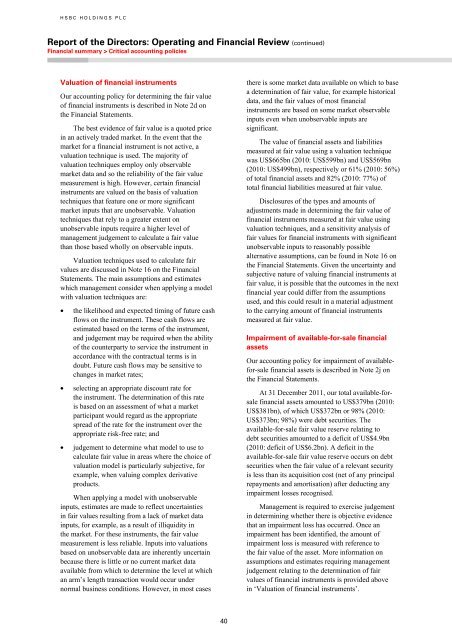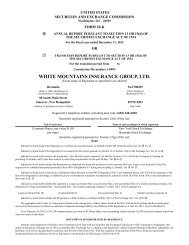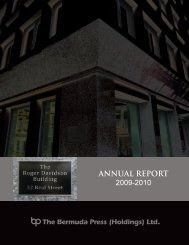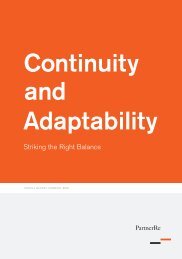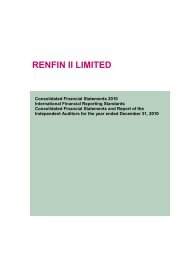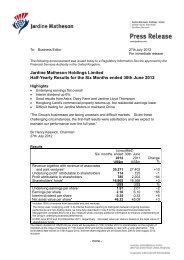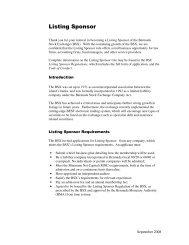Annual Report and Accounts 2011 - Bermuda Stock Exchange
Annual Report and Accounts 2011 - Bermuda Stock Exchange
Annual Report and Accounts 2011 - Bermuda Stock Exchange
Create successful ePaper yourself
Turn your PDF publications into a flip-book with our unique Google optimized e-Paper software.
HSBC HOLDINGS PLC<br />
<strong>Report</strong> of the Directors: Operating <strong>and</strong> Financial Review (continued)<br />
Financial summary > Critical accounting policies<br />
Valuation of financial instruments<br />
Our accounting policy for determining the fair value<br />
of financial instruments is described in Note 2d on<br />
the Financial Statements.<br />
The best evidence of fair value is a quoted price<br />
in an actively traded market. In the event that the<br />
market for a financial instrument is not active, a<br />
valuation technique is used. The majority of<br />
valuation techniques employ only observable<br />
market data <strong>and</strong> so the reliability of the fair value<br />
measurement is high. However, certain financial<br />
instruments are valued on the basis of valuation<br />
techniques that feature one or more significant<br />
market inputs that are unobservable. Valuation<br />
techniques that rely to a greater extent on<br />
unobservable inputs require a higher level of<br />
management judgement to calculate a fair value<br />
than those based wholly on observable inputs.<br />
Valuation techniques used to calculate fair<br />
values are discussed in Note 16 on the Financial<br />
Statements. The main assumptions <strong>and</strong> estimates<br />
which management consider when applying a model<br />
with valuation techniques are:<br />
• the likelihood <strong>and</strong> expected timing of future cash<br />
flows on the instrument. These cash flows are<br />
estimated based on the terms of the instrument,<br />
<strong>and</strong> judgement may be required when the ability<br />
of the counterparty to service the instrument in<br />
accordance with the contractual terms is in<br />
doubt. Future cash flows may be sensitive to<br />
changes in market rates;<br />
• selecting an appropriate discount rate for<br />
the instrument. The determination of this rate<br />
is based on an assessment of what a market<br />
participant would regard as the appropriate<br />
spread of the rate for the instrument over the<br />
appropriate risk-free rate; <strong>and</strong><br />
• judgement to determine what model to use to<br />
calculate fair value in areas where the choice of<br />
valuation model is particularly subjective, for<br />
example, when valuing complex derivative<br />
products.<br />
When applying a model with unobservable<br />
inputs, estimates are made to reflect uncertainties<br />
in fair values resulting from a lack of market data<br />
inputs, for example, as a result of illiquidity in<br />
the market. For these instruments, the fair value<br />
measurement is less reliable. Inputs into valuations<br />
based on unobservable data are inherently uncertain<br />
because there is little or no current market data<br />
available from which to determine the level at which<br />
an arm’s length transaction would occur under<br />
normal business conditions. However, in most cases<br />
there is some market data available on which to base<br />
a determination of fair value, for example historical<br />
data, <strong>and</strong> the fair values of most financial<br />
instruments are based on some market observable<br />
inputs even when unobservable inputs are<br />
significant.<br />
The value of financial assets <strong>and</strong> liabilities<br />
measured at fair value using a valuation technique<br />
was US$665bn (2010: US$599bn) <strong>and</strong> US$569bn<br />
(2010: US$499bn), respectively or 61% (2010: 56%)<br />
of total financial assets <strong>and</strong> 82% (2010: 77%) of<br />
total financial liabilities measured at fair value.<br />
Disclosures of the types <strong>and</strong> amounts of<br />
adjustments made in determining the fair value of<br />
financial instruments measured at fair value using<br />
valuation techniques, <strong>and</strong> a sensitivity analysis of<br />
fair values for financial instruments with significant<br />
unobservable inputs to reasonably possible<br />
alternative assumptions, can be found in Note 16 on<br />
the Financial Statements. Given the uncertainty <strong>and</strong><br />
subjective nature of valuing financial instruments at<br />
fair value, it is possible that the outcomes in the next<br />
financial year could differ from the assumptions<br />
used, <strong>and</strong> this could result in a material adjustment<br />
to the carrying amount of financial instruments<br />
measured at fair value.<br />
Impairment of available-for-sale financial<br />
assets<br />
Our accounting policy for impairment of availablefor-sale<br />
financial assets is described in Note 2j on<br />
the Financial Statements.<br />
At 31 December <strong>2011</strong>, our total available-forsale<br />
financial assets amounted to US$379bn (2010:<br />
US$381bn), of which US$372bn or 98% (2010:<br />
US$373bn; 98%) were debt securities. The<br />
available-for-sale fair value reserve relating to<br />
debt securities amounted to a deficit of US$4.9bn<br />
(2010: deficit of US$6.2bn). A deficit in the<br />
available-for-sale fair value reserve occurs on debt<br />
securities when the fair value of a relevant security<br />
is less than its acquisition cost (net of any principal<br />
repayments <strong>and</strong> amortisation) after deducting any<br />
impairment losses recognised.<br />
Management is required to exercise judgement<br />
in determining whether there is objective evidence<br />
that an impairment loss has occurred. Once an<br />
impairment has been identified, the amount of<br />
impairment loss is measured with reference to<br />
the fair value of the asset. More information on<br />
assumptions <strong>and</strong> estimates requiring management<br />
judgement relating to the determination of fair<br />
values of financial instruments is provided above<br />
in ‘Valuation of financial instruments’.<br />
40


